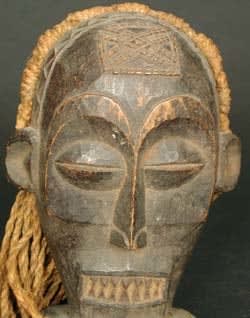Chokwe Wooden Cihongo Mask with Fibrous Hair, 20th Century CE
Wood and Fibers
12.1 x 16.5 cm
4 3/4 x 6 1/2 in
4 3/4 x 6 1/2 in
PF.4775 (LSO)
Further images
This austere and imposing mask with a flat base and a raffia headdress was made by the Chokwe people. The face is more male than female in overall shape, and...
This austere and imposing mask with a flat base and a raffia headdress was made by the Chokwe people. The face is more male than female in overall shape, and has a rather aggressive expression, with particular reference to the thin nose, the bared teeth and the seemingly closed eyes within their large orbits. The angularity of the face is heightened by the straight lines down the side of the eyes, around the mouth and across the cheekbones. The base is flat and has a distinct pedestal form. There is a complex geometric form, or cingelyengelye, on the forehead, which testified to the early influence of Portuguese forces. The headdress is a raffia cap with numerous strands that would have hung down to the wearer’s shoulders.
The Chokwe, or Tchokwe, are distributed across Angola, the DR of Congo and Zambia, and can trace their ancestry to the Lunda Empire of the 15th century, when a mass-migration occurred out of Lunda/Luba territory. The resulting kingdoms – including the Tchokwe, Luena, Songo, Ovimbundu and Imbagala – were all closely allied until the mid 19th century when the Tchokwe, following a great famine, migrated south. Their art and culture is thus distinctive compared to that of the other Lunda-descended tribes.
Society is governed by a God-King (Mwana Ngana), under whom men’s (Mugonge) and women’s (Ukule) societies control age classes and ensure social harmony. This system has resulted in a series of masks that are designed to defuse social tensions, celebrate important events (i.e. circumcisions), impose judiciary powers and promote fertility, health and well-being. Figures are rare, and usually represent Tshibinda Ilunga, the mythical founder of the Chokwe, and queen figures. The main mask forms for which the Tchokwe are known are the male Cihongo mask – which symbolises wealth, power and judicial authority – and the female Pwo mask, which is an embodiment of idealised femininity. The current piece is an exceptional example of the former. The two “sexes” were sometimes danced together at ceremonies to ensure fertility and prosperity.
In practical terms, the Cihongo mask as worn by a vassal of the king, and wearing it conferred judicial power upon him, for the collection of taxes, rates and the like. The identity of the wearer was concealed under the raffia train.
This is an impressive piece of African art.
The Chokwe, or Tchokwe, are distributed across Angola, the DR of Congo and Zambia, and can trace their ancestry to the Lunda Empire of the 15th century, when a mass-migration occurred out of Lunda/Luba territory. The resulting kingdoms – including the Tchokwe, Luena, Songo, Ovimbundu and Imbagala – were all closely allied until the mid 19th century when the Tchokwe, following a great famine, migrated south. Their art and culture is thus distinctive compared to that of the other Lunda-descended tribes.
Society is governed by a God-King (Mwana Ngana), under whom men’s (Mugonge) and women’s (Ukule) societies control age classes and ensure social harmony. This system has resulted in a series of masks that are designed to defuse social tensions, celebrate important events (i.e. circumcisions), impose judiciary powers and promote fertility, health and well-being. Figures are rare, and usually represent Tshibinda Ilunga, the mythical founder of the Chokwe, and queen figures. The main mask forms for which the Tchokwe are known are the male Cihongo mask – which symbolises wealth, power and judicial authority – and the female Pwo mask, which is an embodiment of idealised femininity. The current piece is an exceptional example of the former. The two “sexes” were sometimes danced together at ceremonies to ensure fertility and prosperity.
In practical terms, the Cihongo mask as worn by a vassal of the king, and wearing it conferred judicial power upon him, for the collection of taxes, rates and the like. The identity of the wearer was concealed under the raffia train.
This is an impressive piece of African art.







